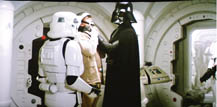.: Technicolor I.B. Screening
Floating around in the world are a few private 35mm copies of the Star Wars films. They are on Eastman Kodak film, and, although different individual prints fade at differing rates, would by now be unpresentable as is. A few weeks ago, I saw a 1975 print of Jaws, and the title card that was supposed to be white-on-black was now white-on-red, so vivid that I thought it was an alternate title card timed to look like blood. Sadly, the rest of the print was very pink. It was also scratched to hell from being played for thirty years. Most of those private prints of Star Wars floating around probably look about the same--even if never played, the photochemical emulsion of Kodak film would have turned pink by now. Except for one print. One print is special. It is a Technicolor imbibition dye-transfer print. This means: it has a finer grain and better picture, but, more importantly, it looks exactly the same as the day it was printed. Properly cared for, it will outlast all of us.
A bit of history is in order here. When color photography was first invented for motion pictures in the 1920s and 1930s, it was achieved through the use of dyes, and eventually Technicolor emerged as the technological leader in this field. They used three strips of dyed black and white film that recorded each spectrum of colour--red, blue and green. When these three strips were combined, a full-colour reproduction was possible, with famously vivid hues. Prints were made through a similar use of dyed strips. By the 1950s, however, Kodak had figured out how to do colour using photochemical emulsions, much like black and white. The earliest efforts were murky and crude, but by the 1960s filmmakers had abandoned the Technicolor three-strip process because Kodak colour film was so much cheaper, even if it wasn't as vivid. Technicolor survived a while longer, however, by offering imbibition (I.B.) dye-transfer prints of Kodak negatives as premium releases.
Regular 35mm prints are made through photochemical means and printed on Kodak Eastman stock. The grain is much coarser than Technicolor, detail not as fine, the colours are less accurate and not as vivid, and until 1982 would fade after a decade. Why does everyone print on photochemical film then? It's really cheap, quick and easy. While Technicolor still made dye-transfer prints in the 1960s, the films of the 1970s made the grainy, desaturated Kodak stocks a virtue through the gritty, countercultural films that were popular at the time. There was no more need for Technicolor and by the 1970s it had closed down in the United States. In Britain, however, it clung to existance for a few more years. When Star Wars opened in England, there were a couple of Technicolor prints made for special showings. George Lucas had one printed for himself--it was used as the reference for the 1997 Special Edition colour timing because it was fade-free. How many of these existed overall? Certainly not more than a handful. Which is why it is fortuitous than one was--somehow--smuggled or obtained through legitimate means (which did sometimes happen in rare circumstances--but probably it was simply stolen). Technicolor closed down in Britain not long after Star Wars opened there, and there were no prints made of the two sequels.
Cut to 2010. Pretty much no one has seen the original version of Star Wars since the 1990s. There are memories of a 70mm revival screening in 1990 in California, but even then the print was starting to go pink, and probably isn't very watchable now. Baltimore's historic Senator Theatre was getting ready to close down after financial troubles, to be transfered to new managers, and owner Tom Kiefaber wanted to send it off in style. His family had owned the theatre for 71 years, and in that time had made a few connections. On the last day of operations, July 21, 2010, amid some moderate media coverage (including ABC news), Kiefaber decided to hold free screenings of Star Wars to a packed house--and not just the original version. He knew of a privately owned Technicolor print.
Probably, this is the same one that filmmaker Richard Haines passed on buying because it had the 1981 crawl spliced onto it, as this one does. A print of the same characeristics was reported to have been put on eBay at one point.
Below are some photos from the night, taken by John Waire. See his photo blog for the full set.

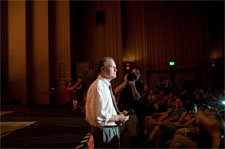
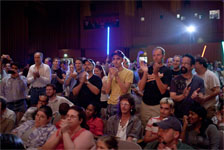


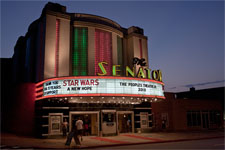
Below is a video clip of the night recorded by a patron. Watch in HD for the full effect:
You can see how terrific the print looks. Very few scratches, and no fading at all, plus a great deal of detail apparent. It doesn't look anything like the 1993 Laserdisc or the 2006 DVD, with all of its dirt and grain, and the colours are terrific. The stardestroyer fly-by looked pretty pink, as it is from a 1981 photochemical splice-in for the re-release that year. ABC news correspondant Christian Schaffer proclaimed "it looked fantastic on the Senator's 40-foot screen!" Owner Tom Kiefaber says during an introduction before the screening:
"This is a I.B. Technicolor print. Let me just give you a little technical thing. This is a stunning print. I just couldn't believe it earlier when I saw this. This print is from 1977. Now, regular film emulsion, you know like 35mm film, it would be pink right now. Just not worth watching. But this is what we call dye-transfer, which means they put layers of dye on this film. And as long as you take care of it, the colours will not fade at all. I mean it's got a few dings here and there that gives it a certain amount of character, but this is the original."
It is rather lucky that the screening happened at all--Adywan, creator of Star Wars Revisited, told of how he saw Star Wars at his local art theatre in 2006 and when Lucasfilm found out they confiscated the print. The Senator was not very well advertised, and most non-locals did not know about it until after it happened, so perhaps they simply flew under the radar. Owner Tom Kiefaber says during an introduction before the screening:
"[Fans] came up to me and said, 'You know, George has kind of crossed over to the dark side a little bit, are you sure there's not Lucas[film] people out here with a jet coming across the country to get this print?' Because, essentially, you know we love George Lucas, but there's been kind of an effort to not have this particular version exist any more. I think it's a mistake, personally. In particular, when you see this you'll realize. Because this is the original."
The screening was a terrific chance for fans to see the film as it was meant to be seen. "Let's turn down the lights and take a magical journey together," was Keifaber's last words before the reels began.
Attendee Peter Gaultney used the occassion to take photos of the screen using his new camera. You can see what Kiefaber is talking about--the velvety Technicolor texture, the clarity and detail and the bright colours. It's also valuable as a colour reference. Now, every Technicolor print is slightly different because of the dye balances, but this is still the best reference for how the film is supposed to look. You also have to account for the fact that the camera photographing the screen will never be 100% faithful to the contrast, intensity or colour balance of the print--but it's a good indicator nonetheless. Linked below is his collection. The full images are 8-11MB in size, with the complete collection weighing in at 312MB, a great resource for purists.
Below are a few choice samples, which I have redone to be more viewable. They have been reduced in size by about 55% (they will still fill your screen), and are between 600kb and 1MB in size. I have not altered colour, brightness or contrast, so as to keep the original photo qualities intact, although occassionally a bit of cropping or distortion was necessary due to the perspective correction.
See Peter Gaultney's page for the full collection of 40 high-res pics:
Three things are apparent from this screening.
1) The R2 canyon scene with the Jawas is supposed to be dusk. There was some debate about this since earlier home videos had the scene in bright day, as it was filmed. In 1993, it was re-timed to be dim and sunset-tinted, which was then greatly embellished in the Special Edition. It was reported that the earlier video versions were mis-timed. While the 1993 telecine might seem to exaggerate the sunset hue a bit, the scene in 1977 is definitely as dark as it is in current versions. There is a tiny green shift in the I.B. print, indicating it is actually slightly warmer.
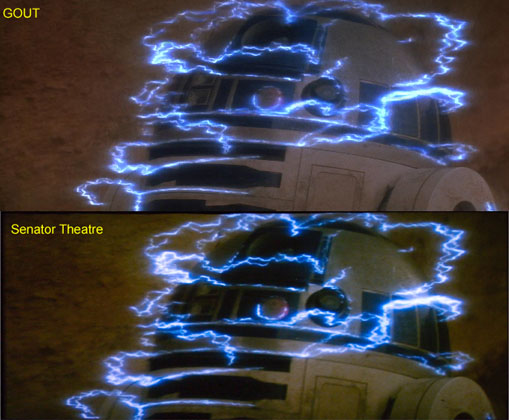
2) There has also been much debate about how the binary sunset scene should look. Earlier home video versions had the scene very bright, and more subdued in its coloring. From 1993 onward, it has gotten significantly darker and more colourful. Based on the photographs here, it appears to have been actually in between the two extremes. It is fairly bright--which makes sense since it is a sunset, lit by direct light, not twilight--and colored a moderate amount of pink/orange. The 1993 transfer darkened it to twilight levels and introduced blue into the timing, providing lots of blue and purple gradients in shots, which the Special Editions have embellished. This 1977 print is basically consistent with the 1977 telecine bootleg, which wasn't reliable because of colour and contrast degradation over the generations of copying.

3) Also, there has been some debate over what colour the Death Star interiors should be. Most fan preservations try to get it grey; Adywan was famously a stickler to get totally neutral colours. The 2006 DVD and 1993/5 Laserdiscs sports this, but the 1985 print used is so washed out and pink-shifted from fading it would have undone any mild colouration that was originally there. This Technicolor transfer is interesting however. While there is always some discolouration or tinting in prints, and the white balance of the camera photographing the screen may shift things further, there is a consistency here in that the Death Star is rarely a neutral grey. It seems to have green in it in most shots to varying degrees, and blue in other shots, with poor consistency. You can tell it is on the print and not from the camera by the consistency and naturalness in skintones, which look far superior than any home video telecine. This is similar to the 70mm cells collection, which also was very green, and occassionally blue. In their book, The Movie Brats, from 1979, the authors refer to the Death Star as a "grey-green" world similar to the Nazis. Coincidence? Not likely. The 1977 telecine bootleg has a similar look. The balance of light, balance on the film stock, and timing of individual shots produced an environment that, even if it were actually painted pure grey (some colour photos from the set look suspiciously grey-green as well, which becomes blue under certain lighting conditions) is tinged. This should be considered a valid element of the film's original cinematography. I confirmed this by taking the 2006 DVD/1993/5LD and pumping up the saturation to the Technicolor levels and then dialing out the pink shift (which means adding green and some yellow) until skin tones looked natural as they do in the Technicolor print--the result was identical color balances. Below are examples of the blue and green tinting on the Technicolor print. You can see that the print and camera is responsible for some of it, but by the natural colour of the skin tones you can tell that it could not possible account for the entirety of the tint.
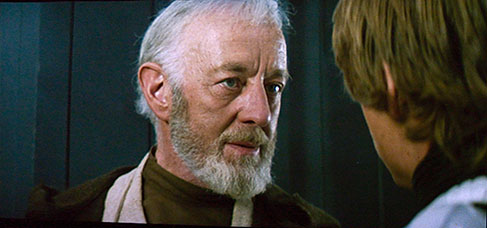
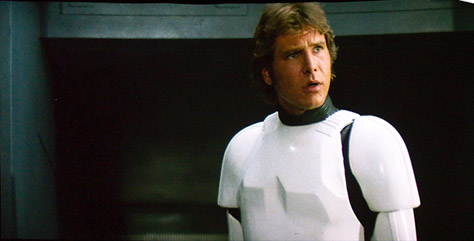
A final question is: what happened to the print after the screening? It didn't self-destruct when the Senator closed its doors. This print is really the holy grail of public Star Wars sources and it is sitting in some cans as you read this.
Below are various links, videos and photos on the screening:
http://johnwairephoto.com/blog/2010/07/21/the-end-of-an-era/
http://charmcityshinobi.tumblr.com/post/844008406/got-to-see-star-wars-a-new-hope-on-the-big-screen
http://www.chicagotribune.com/videobeta/?watchId=6152dbd4-ae00-4fee-988d-2e3f9f05a3f7
